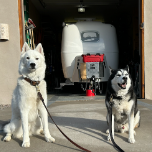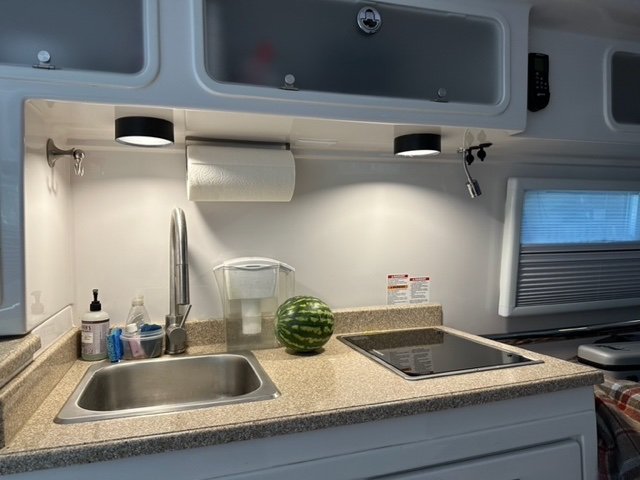
Fritz
Member+-
Posts
222 -
Joined
-
Last visited
-
Days Won
1
Fritz last won the day on December 20 2021
Fritz had the most liked content!
My Info
-
Gender or Couple
Couple
My RV or Travel Trailer
-
Do you own an Oliver Travel Trailer, other travel trailer or none?
I own an Oliver Travel Trailer
-
Year
2021
-
Make
Oliver
-
Model
Legacy Elite II
Recent Profile Visitors
The recent visitors block is disabled and is not being shown to other users.
Fritz's Achievements
-
Dave and Kimberly -- here's a long shot, but ... I sometimes leave the trailer hooked up to shore power but set the "ignition charge control" on the inverter to "auto-off." This allows use of 120V appliances without a constant charge to the batteries. Furthermore, I sometimes also turn off the solar to allow the batteries to drift to a lower SOC (for the health of the batteries). I've noticed the Xantrex charger/inverter draws electricity when simply connected to shore power. Thus, if you have shore power connected but everything else turned off (including solar), the inverter/converter could be drawing enough to contribute to a 3% SOC drop per day.
-
MAX Burner started following Fritz
-
Checking Blum Undermount Drawer Slides
Fritz replied to Fritz's topic in Mechanical & Technical Tips
I used six #6 5/16 screws on each slide. I also made new holes (i.e., I did not reuse previous holes from which the screws had released). #8 5/16 screws would probably also work. I agree with your strategy of installing additional screws, even if not needed,. This will prevent an on-the-road fix later on. -
You may have already fixed this, but just in case: Oliver uses (at least in our 2021 trailer) a push latch like this: https://www.amazon.com/CampN-Pair-Push-Catch-Replacement/dp/B074WFN45Y?th=1. They work well, and should work well as retrofits on older trailers also. A note of caution: their little tabs can break off if a drawer is forced closed and the latch is not in position to accept the tab, rendering the latch useless. But if the drawer is tilting and not sliding correctly, I would check two things first: (1) there is a flat pin at the back of the drawer that has to fit into a hole drilled into the rear wooden drawer panel. If the pin is not in the drawer then the drawer will not be correctly fastened to the Blum slides. Second, if the front drawer latch (the orange one toward the front of the drawer), is not fully attached to the slide then the drawer will tilt and the slide will not operate correctly. If lying on the floor and installing the drawer, you should see and hear the orange latch click into place. Yes, it looks like the orange latches you have in the photo are the correct ones. Our trailer too has these Blum tandem slides. They are arguably among the best in the business. Blum instructions specify mounting the drawer slides to the cabinet wall with 3 screws. This might be fine for non-rolling homes, but rolling kitchens need more screws. After the first year (and 8,000 miles) several of ours had jiggled loose (leading the slides to move and the drawers to appear tilted). I installed more screws into each slide (after removing the drawers from the slides) and have not had a problem since.
-
For insulation, there is a layer of 1/4" thick (I think) reflectix installed between the hulls. Mostly installed, I should say, in that insulation has gaps in some corners (such as behind some cabinet areas. Layers of reflectix in our trailer are not taped together at seams, so there is room for air movement at corners and reflective joints. Theoretically, I would love to see more insulation between the hulls (reducing loads on the AC and furnace), but air and space between the hulls is what lets moisture (if present) seep toward the bottom of the hull and out one of the scupper drains. Reflectix helps reduce radiant heat transfer under a hot sun. It probably also helps with conductive heat transfer. There is still ample space between the hull walls, so I'm not sure how much it helps with convective heat transfer. I have found the combination of double hull walls, double-pane windows, and AC effective in hot western weather, at least into the low 100°F range. Our 2021 AC is noisy, but gets the job done. Battery compartment can get warm, especially at high charge rates in hot weather. All of that said, we prefer to seek out higher elevations and/or shade on hot days.
-
Thanks. How might you do it differently?
-
Actually, I did have to replace a touch light for which I had installed a shade. I sprayed a little bit of rubbing alcohol around the base of the shade where it was stuck to the fiberglass, wiggled it a bit, and the shade came right off. I replaced the touch light, and reinstalled the shade.
-
Thanks. Newer trailers (at least our 2021 trailer) have five touch lights. The 4” pipe flanges form a tight friction fit around these touch lights. I did not try the concept with other lights (such as those on the ceiling or in the cabinets). Other sizes of pipe or associated fittings might work well for your lights. Good luck!
-
Did you use a portable circular saw, or did your jig function as a sled on a table saw? Were your 2x4s attached to the plywood so as to create a channel to hold the pvc pipe?
-
I’ve replaced two, and then had to replace one of the replacements. Failure seems to begin with flickering or dimming.
-
Thanks for the correction. I used a couple fittings that I had sitting around from a project I did 20 years ago. And I just checked the Home Depot website—these fittings have become expensive! So, if you have to go buy fittings to cut up for shades you will hopefully find a cheaper alternative to the ABS fittings that I used.
-
It's a minor issue, but sitting at the dinette or lying in bed we found the touch lights can be glaringly bright. I discovered that a 4" PVC sewer-pipe connector has a flange that is the ideal diameter for slipping over the touch light to create a light shade. To create a shade I cut off the flange from a connector using the band saw. This is the cut end that slips over the light... This is the finished end that becomes the bottom of the shade: The shade slips over the light and stays in place with a friction fit, but a bit of 3M double stick tape provides insurance: Dinette touch light, without shade: Dinette light, with shade: Galley lights, with shades: Shade installation does not appear to have any effect on light operation--they still turn on and off by touch. I suppose that the flanges could be cut with a hand saw (hack saw, coping saw?), which would likely require some additional filing and sanding. Also, the shades could be painted white, but for now we've stuck with plain black.
-
I use an aero press: https://www.amazon.com/AeroPress-Portable-Travel-Coffee-Press/dp/B07YVL8SF3/ref=sr_1_6?crid=2IDH7CBZ1K29E&keywords=aeropress&qid=1698864367&sprefix=aero%2Caps%2C311&sr=8-6. Good coffee, extremely easy cleanup, small storage space required. Takes fine-ground coffee (I bring along an electric grinder); for a large mug the first pour of 170°-water is drip, the second pour is press.
-
Newbies taking the plunge - Are we missing anything
Fritz replied to Dennis and Melissa's topic in General Discussion
I'm not sure what "normal" is for these inverters. However, there is a charge setting (at least for the 3000 W unit, and I think for the 2000 W unit) whereby you can control charging. When the "charger ignition control" is "off" then the batteries will charge automatically when you plug into shore power. When the "charger ignition control" is in the "auto-on" position the 120 V electrical system is powered, but the batteries do not charge from shore power (the batteries still charge from solar, if available). I know, the names and settings are not fully intuitive. -
Newbies taking the plunge - Are we missing anything
Fritz replied to Dennis and Melissa's topic in General Discussion
I use the 3000W inverter/charger that came with the solar/battery package. There are several ways to monitor voltage in the batteries in our 2021 LE2: solar controller, inverter remote, and Lithionics battery app. The only one that lets you see a precise voltage (in my experience) is the battery app. With a 2020 trailer you may have the LifeBlue (?) batteries, which may have a different charge monitor or different battery app. When charging, the batteries slowly approach 14.4V, and once they reach this voltage will remain there for a minute (or even seconds), then slowly revert to a resting voltage closer to 13.6V. It's very easy to miss the precise point when the batteries reach 14.4V. To confirm that they've reached 14.4V, you have to watch the battery voltage continuously as the batteries approach 14.4V. One way to confirm that the voltage should be reaching 14.4V might to check the Xantrex inverter's charge settings. The default custom absorption voltage is 14.6V, which, as I understand it, allows the batteries to charge to 14.4V. See link below. Hope this helps. -
Newbies taking the plunge - Are we missing anything
Fritz replied to Dennis and Melissa's topic in General Discussion
With management, we can generally go longer (with substantially more small showers during this time) without needing to empty the gray water tank. We extend the gray-water tank in two ways. First, we use a solar shower bag (fill it with hot water from the trailer's tank or with water from campground faucet heated on the stove or by leaving it in the sun). This prevents the substantial amount of water that flows into the gray-water tank while adjusting the shower-water temperature, and reduces the amount of shower water needed. Second, we frequently fill tubs for dishes with hot tank water or heated campground water, emptying the tubs into the woods. Again, these measures extend our fresh-water tank and reduce the amount of water filling the gray-water tank.










